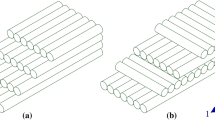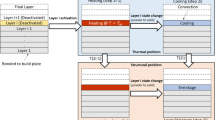Abstract
Additive manufacturing has evolved from a rapid prototyping tool to a set of manufacturing processes for functional parts. One of their most outstanding features is the ability to build complex geometry parts. However, their industrial application is limited because these parts exhibit heterogeneous and porous micro/mesostructures with anisotropic behavior. These structural characteristics, mainly porosity, are strongly related to the building parameters. In this work, a computational multiscale homogenization approach was implemented to determine the mechanical properties of unidirectional and criss-cross mesostructures generated by a material extrusion process (MEP). Representative volume elements (RVE) for simplified and real-like pore geometries were created to model the mesostructures and to perform the multiscale analysis. Stiffness tensor for each RVE was obtained and graphically represented to observe the mechanical properties as a function of the orientation. A great influence of the pore geometry on mechanical properties was observed. Finally, by comparing with experimental data, the results obtained were validated.











Similar content being viewed by others
References
Bamiduro O, Owolabi G, Haile MA, Riddick JC (2019) The influence of load direction, microstructure, raster orientation on the quasi-static response of fused deposition modeling ABS. Rapid Prototyp J 25:462–472
Chacón JM, Caminero MA, García-Plaza E, Núnez PJ (2017) Additive manufacturing of PLA structures using fused deposition modelling: effect of process parameters on mechanical properties and their optimal selection. Mater Des 124:143–157
Ahn SH, Montero M, Odell D, Roundy S, Wright PK (2002) Anisotropic material properties of fused deposition modeling ABS. Rapid Prototyp J 8:248–257
Goh GD, Yap YL, Tan HKJ, Sing SL, Goh GL, Yeong WY (2020) Process–structure–properties in polymer additive manufacturing via material extrusion: a review. Crit Rev Solid State Mater Sci 45(2):113–133
Smith J, Xiong W, Yan W, Lin S, Cheng P, Kafka OL, Wagner GJ, Cao J, Liu WK (2016) Linking process, structure, property, and performance for metal-based additive manufacturing: computational approaches with experimental support. Comput Mech 57:583–610
Jiménez M, Romero L, Domínguez IA, Espinosa MM, Domínguez M (2019) Additive manufacturing technologies: an overview about 3D printing methods and future prospects. Complexity 2019:1–30
Dawoud M, Taha I, Ebeid SJ (2016) Mechanical behaviour of ABS: an experimental study using FDM and injection moulding techniques. J Manuf Process 21:39–45
Al-Maharma AY, Patil SP, Markert B (2020) Effects of porosity on the mechanical properties of additively manufactured components: a critical review. Mater Res Express 7:122001
Kuznetsov VE, Tavitov AG, Urzhumtsev OD, Mikhalin MV, Moiseev AI (2019) Hardware factors influencing strength of parts obtained by fused filament fabrication. Polym J 11(11):1870
Turner BN, Strong R, Gold SA (2014) A review of melt extrusion additive manufacturing processes: I. Process design and modeling. Rapid Prototyp J 20:192–204
Sanchez LC, Beatrice CAG, Lotti C, Marini J, Bettini SHP, Costa LC (2019) Rheological approach for an additive manufacturing printer based on material extrusion. Int J Adv Manuf Technol 105(5):2403–2414
Jiang J, Fu YF (2020) A short survey of sustainable material extrusion additive manufacturing. Aust J Mech Eng:1–10
Jiang J, Lou J, Hu G (2019) Effect of support on printed properties in fused deposition modelling processes. Virtual Phys Prototyp 14(4):308–315
Coogan TJ, Kazmer DO (2017) Bond and part strength in fused deposition modeling. Rapid Prototyp J 23:414–422
Rodriguez JF, Thomas JP, Renaud JE (2000) Characterization of the mesostructure of fused-deposition acrylonitrile-butadiene-styrene materials. Rapid Prototyp J 6:175–186
Tronvoll SA, Welo T, Elverum CW (2018) The effects of voids on structural properties of fused deposition modelled parts: a probabilistic approach. Int J Adv Manuf Technol 97:3607–3618
Wang X, Zhao L, Fuh JYH, Lee HP (2019) Effect of porosity on mechanical properties of 3D printed polymers: experiments and micromechanical modeling based on X-ray computed tomography analysis. Polym J 11(7):1154
Papon EA, Haque A (2018) Tensile properties, void contents, dispersion and fracture behaviour of 3D printed carbon nanofiber reinforced composites. J Reinf Plast Compos 37:381–395
Nouri H, Guessasma S, Belhabib S (2016) Structural imperfections in additive manufacturing perceived from the X-ray micro-tomography perspective. J Mater Process Technol 234:113–124
Chen RK, Lo TT, Chen L, Shih AJ (2015) Nano-CT characterization of structural voids and air bubbles in fused deposition modeling for additive manufacturing. In: ASME 2015 International Manufacturing Science and Engineering Conference. American Society of Mechanical Engineers Digital Collection
Riddick J, Hall A, Haile M, Von Wahlde R, Cole D, Biggs S (2012) Effect of manufacturing parameters on failure in acrylonitrile-butadiane-styrene fabricated by fused deposition modeling. In 53rd AIAA/ASME/ASCE/AHS/ASC Structures, Structural Dynamics and Materials Conference 20th AIAA/ASME/AHS Adaptive Structures Conference 14th AIAA:1571
Rezayat H, Zhou W, Siriruk A, Penumadu D, Babu SS (2015) Structure–mechanical property relationship in fused deposition modelling. Mater Sci Technol 31(8):895–903
Askanian H, Muranaka de Lima D, Commereuc S, Verney V (2018) Toward a better understanding of the fused deposition modeling process: comparison with injection molding. 3D. Print Addit Manuf 5(4):319–327
Andrzejewska A, Pejkowski Ł, Topoliński T (2019) Tensile and fatigue behavior of additive manufactured polylactide. 3D. Print Addit Manuf 6(5):272–280
Croccolo D, De Agostinis M, Olmi G (2013) Experimental characterization and analytical modelling of the mechanical behaviour of fused deposition processed parts made of ABS-M30. Comput Mater Sci 79:506–518
Casavola C, Cazzato A, Moramarco V et al (2016) Orthotropic mechanical properties of fused deposition modelling parts described by classical laminate theory. Mater Des 90:453–458
Domingo-Espin M, Borros S, Agullo N, , Garcia-Granada, A. A., & Reyes, G. (2014) Influence of building parameters on the dynamic mechanical properties of polycarbonate fused deposition modeling parts. 3D Print Addit Manuf 1(2):70-77
Cuan-Urquizo E, Barocio E, Tejada-Ortigoza V, Pipes RB, Rodriguez CA, Roman-Flores A (2019) Characterization of the mechanical properties of FFF structures and materials: a review on the experimental, computational and theoretical approaches. Materials 12(6):895
Popescu D, Zapciu A, Amza C, Baciu F, Marinescu R (2018) FDM process parameters influence over the mechanical properties of polymer specimens: a review. Polym Test 69:157–166
Harris M, Potgieter J, Archer R, Arif KM (2019) Effect of material and process specific factors on the strength of printed parts in fused filament fabrication: a review of recent developments. Materials 12(10):1664
Reuniting design and manufacturing: best practices and overcoming challenges in additive manufacturing. Available online: https://www.nxtbook.com/nxtbooks/mal/3dp_pennstate/. Access on April 1, 2021
Mercado-Colmenero JM, Rubio-Paramio MA, la Rubia-Garcia MD, Lozano-Arjona D, Martin-Doñate C (2019) A numerical and experimental study of the compression uniaxial properties of PLA manufactured with FDM technology based on product specifications. Int J Adv Manuf Technol 103(5):1893–1909
Sood AK, Ohdar RK, Mahapatra SS (2012) Experimental investigation and empirical modelling of FDM process for compressive strength improvement. J Adv Res 3(1):81–90
Sood AK, Ohdar RK, Mahapatra SS (2010) Parametric appraisal of mechanical property of fused deposition modelling processed parts. Mater Des 31:287–295
Alafaghani A, Qattawi A, Alrawi B et al (2017) Experimental optimization of fused deposition modelling processing parameters: a design-for-manufacturing approach. Procedia Manuf 10:791–803
Okereke MI, Akpoyomare AI (2013) A virtual framework for prediction of full-field elastic response of unidirectional composites. Comput Mater Sci 70:82–99
Tronvoll SA, Vedvik NP, Elverum CW, Welo T (2019) A new method for assessing anisotropy in fused deposition modeled parts using computed tomography data. Int J Adv Manuf Technol 105(1):47–65
Rodríguez JF, Thomas JP, Renaud JE (2001) Mechanical behavior of acrylonitrile butadiene styrene (ABS) fused deposition materials. Experimental investigation. Rapid Prototyp J 7:148–158
Xia Z, Chen Y, Ellyin F (2000) A meso/micro-mechanical model for damage progression in glass-fiber/epoxy cross-ply laminates by finite-element analysis. Compos Sci Technol 60(8):1171–1179
Somireddy M, Czekanski A (2017) Characterization of material behavior of the fused deposition modeling processed parts, In: ASME 2017 12th International Manufacturing Science and Engineering Conference collocated with the JSME/ASME 2017 6th International Conference on Materials and Processing, pp. V002T01A014–V002T01A014 American Society of Mechanical Engineers
Garg A, Bhattacharya A (2017) An insight to the failure of FDM parts under tensile loading: finite element analysis and experimental study. Int J Mech Sci 120:225–236
Somireddy M, Singh CV, Czekanski A (2019) Analysis of the material behavior of 3D printed laminates via FFF. Exp Mech 59(6):871–881
Li S, Wongsto A (2004) Unit cells for micromechanical analyses of particle-reinforced composites. Mech Mater 36(7):543–572
Xia Z, Zhou C, Yong Q, Wang X (2006) On selection of repeated unit cell model and application of unified periodic boundary conditions in micro-mechanical analysis of composites. Int J Solids Struct 43(2):266–278
Cao, Y (2016) Representative Volume Element (RVE) Finite-Element Analysis (FEA) of Al Metal-matrix Composites (Master's thesis, University of Wisconsin-Milwaukee) Retrieved from https://dc.uwm.edu/etd/1256
Gao L, Wang C, Liu Z et al (2017) Theoretical aspects of selecting repeated unit cell model in micromechanical analysis using displacement-based finite element method. Chin J Aeronaut 30(4):1417–1426
Nguyen VD, Béchet E, Geuzaine C, Noels L (2012) Imposing periodic boundary condition on arbitrary meshes by polynomial interpolation. Comput Mater Sci 55:390–406
Smit RJ, Brekelmans WM, Meijer HE (1998) Prediction of the mechanical behavior of nonlinear heterogeneous systems by multi-level finite element modeling. Comput Methods Appl Mech Eng 155(1-2):181–192
Kouznetsova V, Brekelmans WAM, Baaijens FPT (2001) An approach to micro-macro modeling of heterogeneous materials. Comput Mech 27(1):37–48
Qi Z, Liu Y, Chen W (2019) An approach to predict the mechanical properties of CFRP based on cross-scale simulation. Compos Struct 210:339–347
ASTM International (2010) ASTM D638 standard test method for tensile properties of plastics. ASTM International, West Conshohocken
Guessasma S, Belhabib S, Nouri H, Ben Hassana O (2016) Anisotropic damage inferred to 3D printed polymers using fused deposition modelling and subject to severe compression. Eur Polym J 85:324–340
Torrado AR, Shemelya CM, English JD et al (2015) Characterizing the effect of additives to ABS on the mechanical property anisotropy of specimens fabricated by material extrusion. 3D Print Addit Manuf 6:16–29
Bellini A, Güçeri S (2003) Mechanical characterization of parts fabricated using fused deposition modeling. Rapid Prototyp J 9:252–264
Acknowledgements
The authors would like to acknowledge the DGAPA-UNAM for supporting the project IN113315 and IG100220. CONACyT is also acknowledged for the grants CF-MG-140617 and LN314934. Luis Sánchez-Balanzar wants to thank the CONACYT for the support awarded through the scholarship for studies in PhD, CVU 421438.
Availability of data and material
All data generated or analyzed during this study are included in this manuscript.
Code availability
Not applicable.
Funding
This work has been supported by:
• Dirección General de Asuntos del Personal Académico-Universidad Nacional Autónoma de México (DGAPA-UNAM) through the project IN113315 and IG100220.
• Consejo Nacional de Ciencia y Tecnología (CONACyT) by the grants CF-MG-140617 and LN314934 and the scholarship with CVU 421438 awarded for PhD. studies.
Author information
Authors and Affiliations
Corresponding author
Ethics declarations
Conflict of interest
The authors declare no competing interests.
Additional information
Publisher’s note
Springer Nature remains neutral with regard to jurisdictional claims in published maps and institutional affiliations.
Rights and permissions
About this article
Cite this article
Sánchez-Balanzar, L., Velázquez-Villegas, F., Ruiz-Huerta, L. et al. A multiscale analysis approach to predict mechanical properties in fused deposition modeling parts. Int J Adv Manuf Technol 115, 2269–2279 (2021). https://doi.org/10.1007/s00170-021-07287-w
Received:
Accepted:
Published:
Issue Date:
DOI: https://doi.org/10.1007/s00170-021-07287-w




